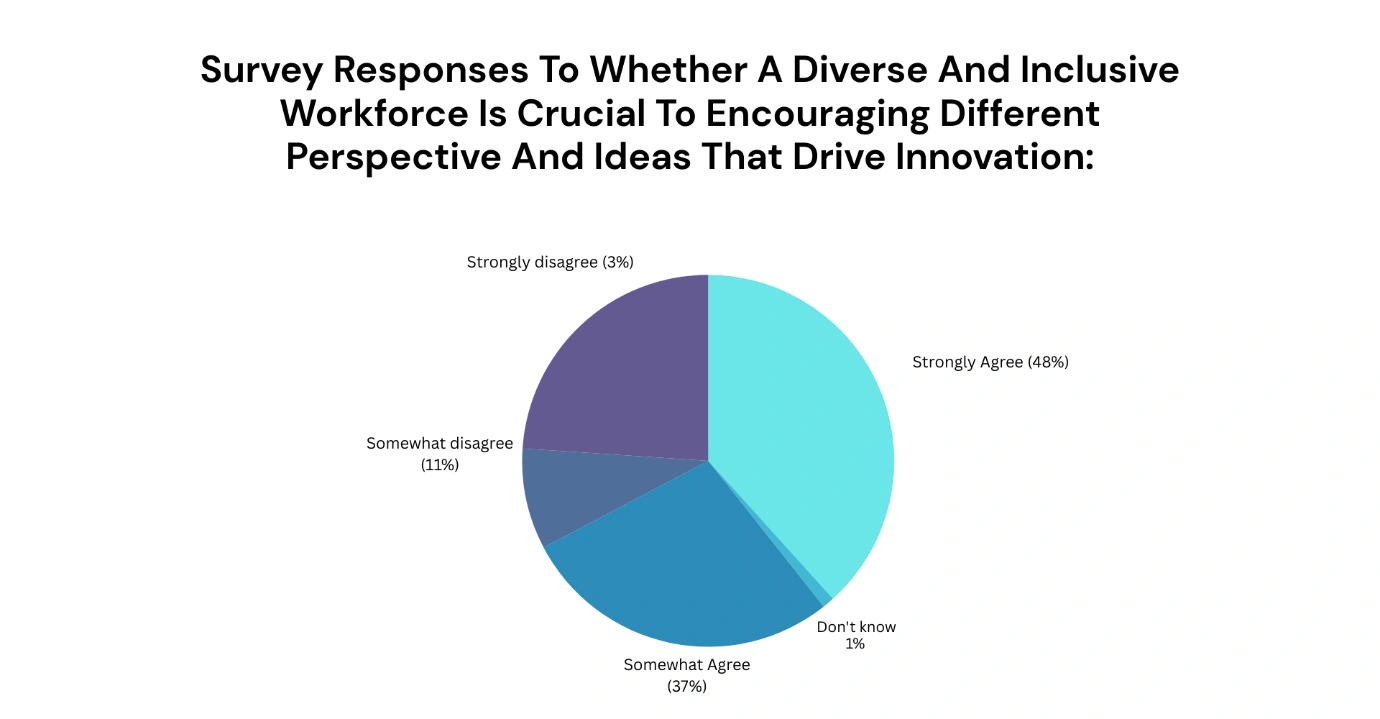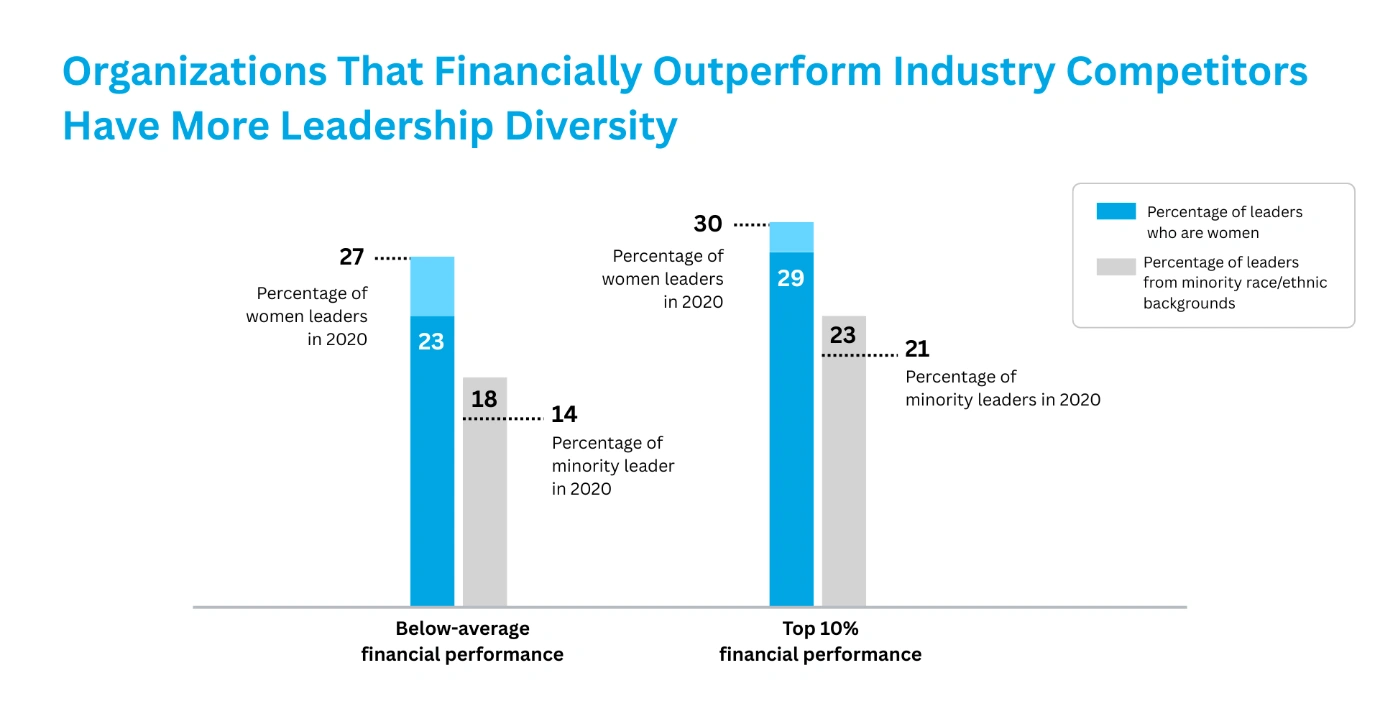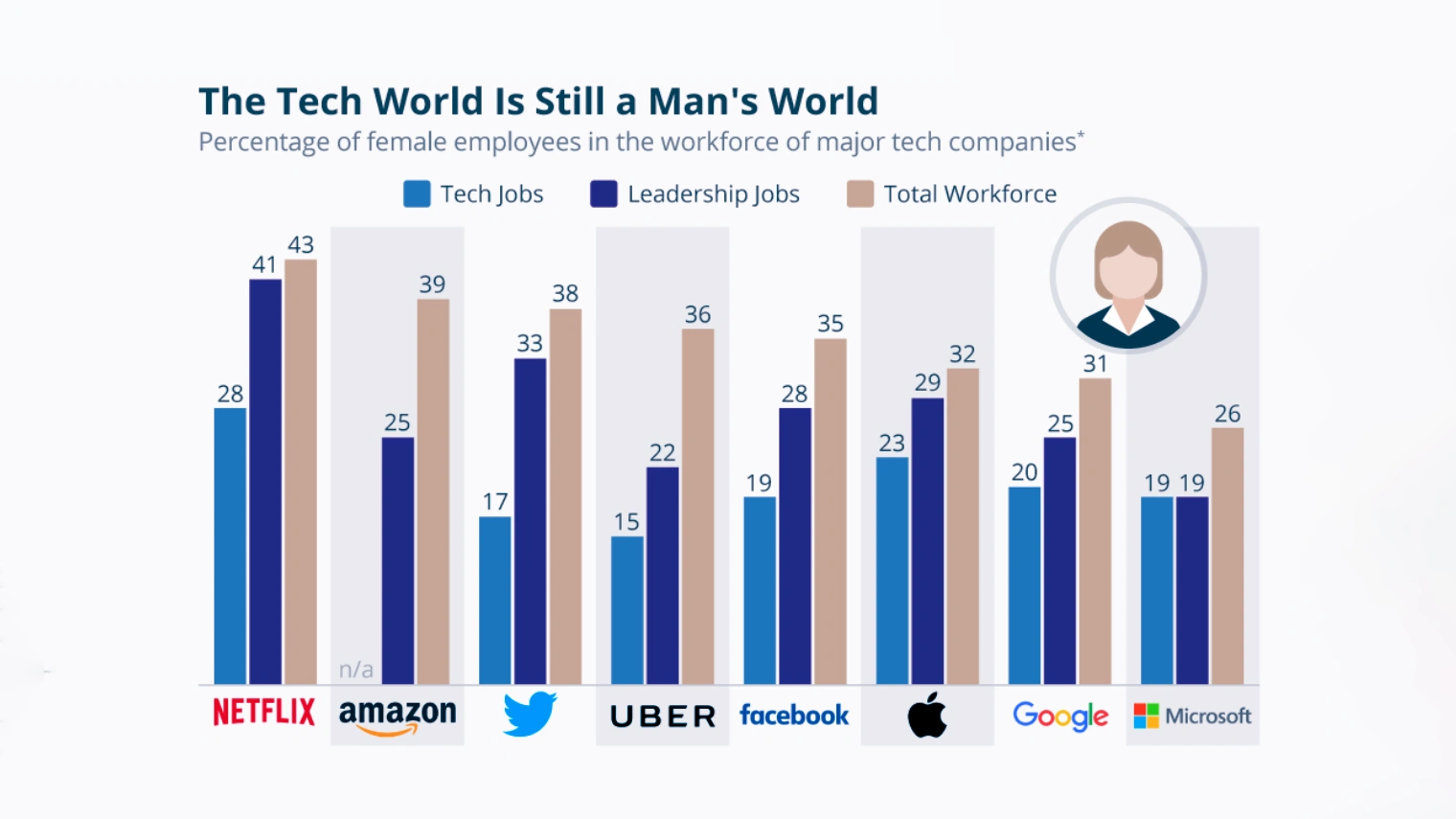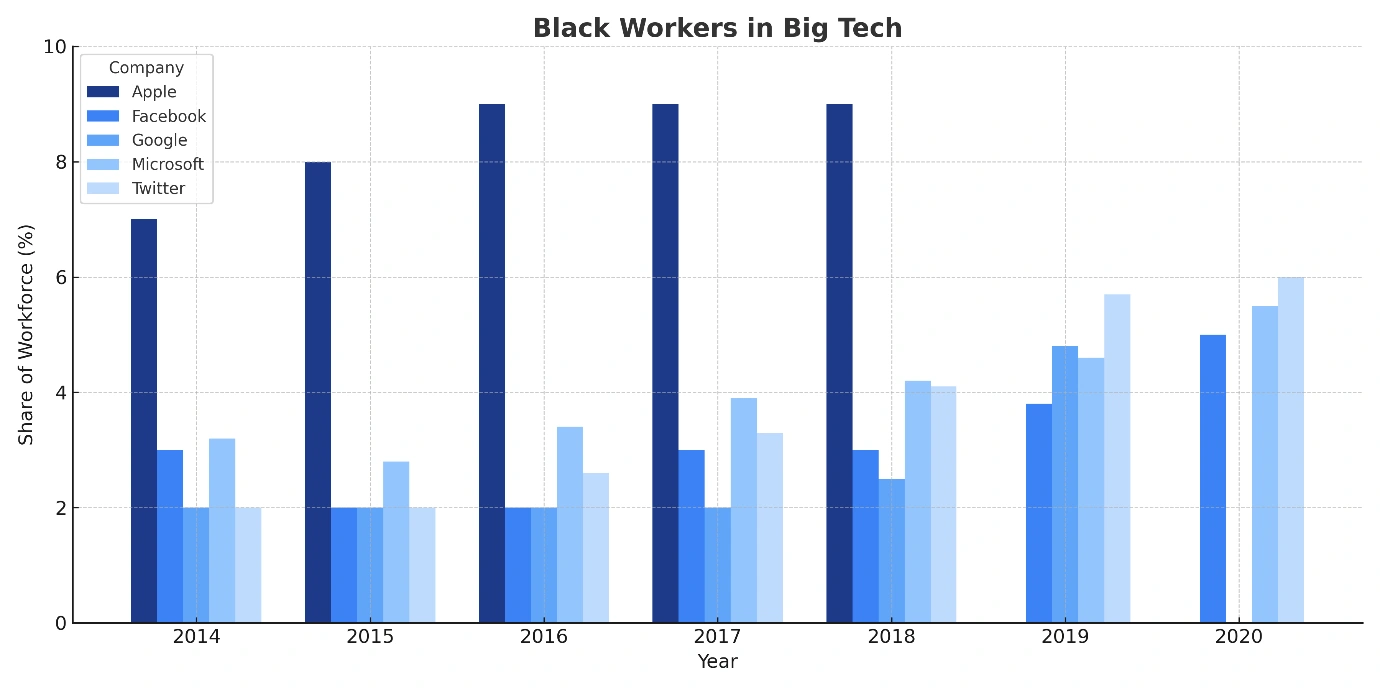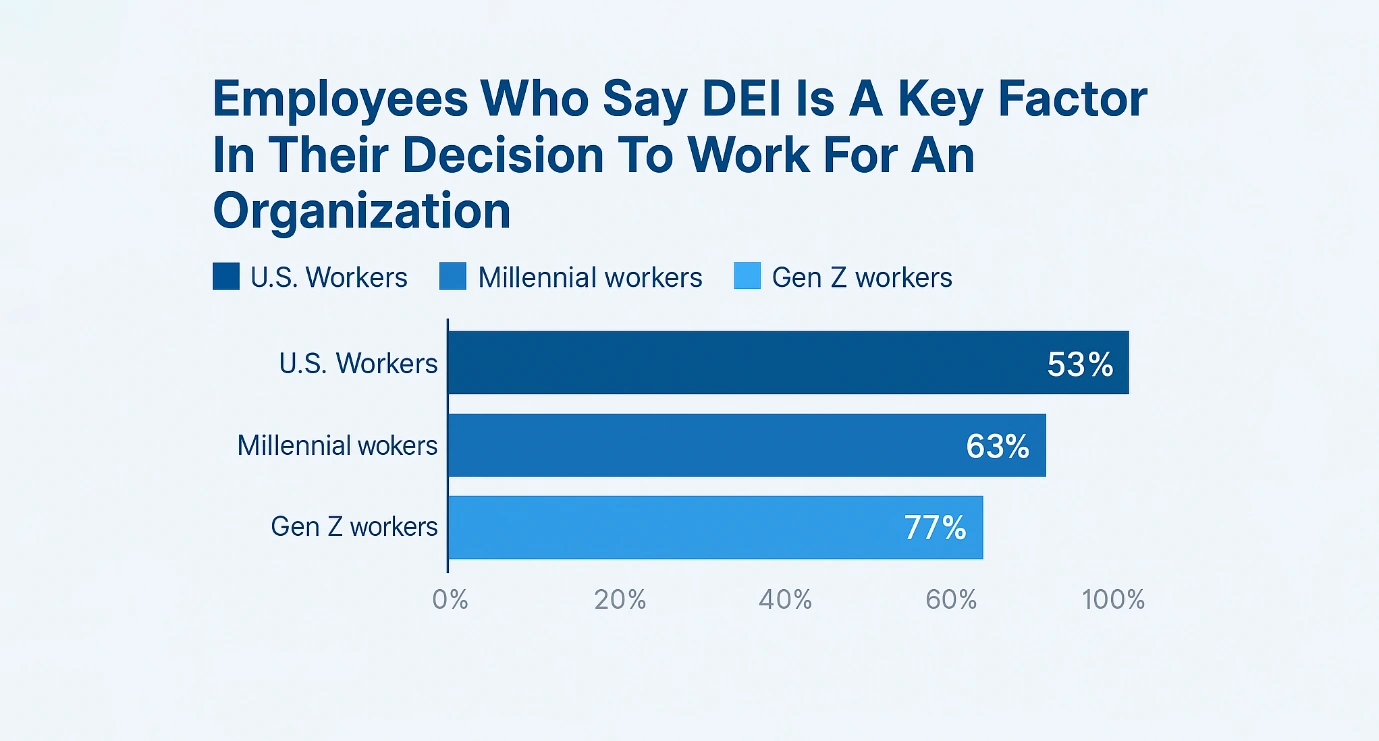Despite the growing awareness about diversity, the tech industry has a long way to go. A 2023 report from the Equal Employment Opportunity Commission (EEOC) revealed that Black workers have only 7% contribution to the total U.S. tech workforce, despite being 13% of the population. Numbers for Hispanic workers are slightly better at 8%, but they’re still underrepresented, given that they are 18% of the population. Women hold only 26% of tech roles, a number that hasn’t increased much in a decade. And when it comes to positions of leadership, there are fewer than 10% women or people of color in the tech force. Disability inclusion is another area that has been overlooked. Out of a 20 percent disabled population, only about 4% work in the tech industry. Ageism is another discriminator in the tech industry, as workers over 40 often feel left out or undervalued in a youth-centered tech industry. While these numbers clearly show the underrepresentation of certain groups, the issues are much more complex if we go deeper. So, let’s begin by learning the importance of diversity. Later, we will discuss the challenges of achieving diversity and possible solutions. In this Blog let’s explore Diversity in Tech: How Companies Are Addressing Inclusivity and Representation in the Tech Workforce.
Why is Diversity in Tech Important
Now, you must be thinking why diversity is being promoted so much. There is a reason diversity is emphasized. It offers many real, measurable benefits. Here are some benefits of a diverse workforce.
When there is diversity, there is innovation.
Innovative ideas come out when you challenge the obvious and look beyond. But how is it done? It is done through thinking differently, assuming the probable questions, and exploring solutions. When people with a single perspective work, the understanding is limited, and so are the solutions. However, when people from diverse backgrounds come, they can bring various perspectives to problems. As their perspective is shaped by their cultural backgrounds, experiences, and personal views, it leads to creative and more innovative solutions.
The most successful products and solutions are those that consider the needs of a wide range of consumers. And, that can only happen if the team developing integrates the ideas and experience of a wide range of consumers through their own unique user experiences. Take, for example, voice recognition. If the voice recognition only recognized the voice of a certain linguistic group, it would never work. Without diversity, many of these ideas may die down.
Helps solve problems better with diverse solutions
The tech industry faces unique and complex problems. Like when the cloud made storing data easy, it created the problem of data theft and security breaches. So, every innovation brings unique challenges with it. And this is where diversity is really beneficial. Diversity promotes multidimensional thinking, and it is also a proven fact that teams with diverse members solve problems better and more accurately.
The different experiences and backgrounds of the people help them view a situation differently. Like, a person from a country with strict data privacy laws would prioritize GDPR compliance and data transparency compared to a person who has no experience with data safety. A team with different experiences would consider various variables for a single problem and come up with the most feasible solutions.
Diversity ensures that the products are effective for everyone.
Technology is universal and should be accessible and useful for everyone, regardless of their region, culture, gender, or socioeconomic status. But the issue is that most of the tech products are created by people who represent a certain region, gender, social class, etc. It is a disadvantage as it creates a risk of exclusion and bias.
One of the biggest examples is facial recognition technology. It faced criticism from all over for not identifying dark skinned people, women, and Asian, Middle Eastern, and African people. It happened because the datasets given to train the models were basically of light-skinned men. Also, as the team developing the technology did not have diverse members, they missed out on this big flaw.
So, when a team is diverse and includes people of different genders, ethnicities, and cultural backgrounds, it can understand the nuances of its user base and create products that work for everyone.
Inclusive Teams Challenge Groupthink
When everyone on a team belongs to the same background, there is hardly anyone to challenge their viewpoint. They think alike, and this is what is called groupthink. It is a situation when everyone agrees to a certain thing without debating or critical thinking. This kind of situation results in creating products with low vision and less impact.
Such a situation can be averted if a team has diverse perspectives. Every aspect is then evaluated critically, and after considering alternative viewpoints, a well-thought-out outcome emerges. In the tech world, groupthink is a hurdle for innovation and creating smart products.
Better Preparedness for the Future
The tech world keeps on evolving, and consequently, it throws different challenges. Companies that can think outside the box and adapt are the ones that can survive. A company with employees with varied experiences is better equipped to do this, as every employee brings their unique ideas to the table.
For example, diverse teams working on early warning systems and smart infrastructure are more likely to think about how these systems will work in various regions and parts of the world. They would be able to think ahead and find a solution for the future. Simply put, a person knowing the challenges of flood-prone areas would suggest creating water-resistant hardware.
Businesses with less diversity don’t succeed long-term
The tech industry is competitive, and if the businesses fail to deliver products that cover a large number of consumers, they may not survive long. Diversity is good for companies as they can make better, innovative products for a large consumer base.
But diversity not only helps create better products but also improves profitability. Studies show that companies with diverse teams perform better than their competition in market share and employee satisfaction.
A McKinsey report also verifies this. It revealed that companies with leadership were 36% more likely to outperform their peers financially. The reason is simple: Inclusive teams understand the needs of a wider consumer market. This helps them create products that have a global appeal.
Challenges to achieving DEI in tech
Implementing DEI in tech companies is challenging for many reasons. Below are some of the most common challenges of inclusive hiring in tech.
Tech is a male-dominated industry.
Tech is considered a field most appropriate for males. This bias makes it difficult for women to consider tech as a career option. However, his perception is changing over time, with many women taking tech roles.
Few role models for underrepresented groups
Another challenge is the lack of role models for people. When joining an industry, people have a vision or role model to look up to. For women and underrepresented groups, there are very few role models to look up to and imagine a future for themselves. They don’t see people like them in a leadership role.
Lack of data
Companies don’t have the data to track the current state of DEI in their organization. They also don’t have methods to measure growth in their DEI initiatives. Lack of tangible efforts slows down the DEI goals.
Attrition and slow growth
Companies that are DEI-focused often struggle to hire qualified candidates. And if they hire, many candidates leave sooner because they feel left out and are not getting equal opportunities. Moreover, the lack of mentorship or inclusive leadership makes it harder for them to grow their career.
Pipeline Issues
Due to the industry’s perceived biases in hiring practices, companies often fail to attract qualified candidates from other ethnicities, with disabilities, or candidates from the 2SLGBTQI+ community.
Limited Access to STEM Education
Low-income or marginalized communities attend schools that lack updated technology, experienced STEM teachers, or extracurricular coding programs. This unequal access further reduces their chances.
Strategies to improve diversity in organizations
Many tech companies have made claims of improving diversity and inclusion in work places. But promises without making tangible improvements quickly get ignored. So, it is important for organizations to take real action that has a direct impact on DEI. As it is a long-term commitment and not a time goal, it has to be carefully assessed and monitored. Here are some strategies that can help you.
Understand the challenges and goals.
Before creating any strategies, you need to know the current state of DEI in your organization. Besides, you must know the challenges you face. Having a clear picture through auditing your DEI policies will help you form attainable strategies.
- Talk to your employees, survey your staff, so that you can understand your areas of improvement.
- Communicate with your team and people who have experience so that you can collaborate with them on making comprehensive strategies.
Finally, set clear goals for your team using the SMART model (Specific, Measurable, Achievable, Relevant, Time-bound). Also, track and measure your DEI success with data.
Reform Recruitment Practices
To improve diversity in tech, companies must update the way they hire people. Here are some suggestions.
- Choose a wide range of talent boards to post open roles. This will encourage diverse employees to apply for them.
- Work with organizations that support underrepresented groups, like Historically Black Colleges and Universities (HBCUs) or Women in Technology (WIT).
- To make hiring fair and inclusive, write job descriptions that don’t favor one group over another.
- When screening, remove names and personal info from resumes. Known as blind screening, this process avoids unconscious bias.
- Include diverse people in interview panels and use structured interview questions so every candidate is judged equally.
- Make jobs open to people in any location to reach a wider, more diverse talent pool.
Create an Inclusive Culture
An inclusive workplace culture makes everyone feel safe and valued. As building this kind of culture takes time, companies need to make conscious efforts.
- Start by helping your team understand and reduce the unconscious bias that they don’t realize they are making.
- Offer workshops or training so employees can learn how to treat others fairly. Also, support diverse employees with mentors who can guide them in their careers.
- Create safe spaces for employees to discuss, share stories, and support each other. Allow them to share feedback, suggest ideas, and help shape company decisions.
- Listening to employees who face challenges and working with them to improve things helps build trust among employees.
Develop Policies For Equal Opportunities
Not everyone gets a similar chance to learn and grow. That’s why companies must offer fair and easy-to-access training for everyone. This includes training, mentorships, and access to tools.
- Some employees can’t afford learning programs, so they offer support to pursue online programs. You can also provide financial help and offer learning during work hours.
- Showcase the success of diverse team members and celebrate their wins across the company. This helps inspire others and shows everyone they have a fair chance of success.
- Pay and promotions should also be fair. A study shows there’s an 11% pay gap in tech between different groups doing the same work. Do regular pay audits to make sure everyone is paid equally for equal work.
- Offer bonuses based on performance, but ensure all employees have an equal shot at earning them.
Use Technology for DEI goals.
Technology plays a big role in supporting DEI goals. Use tools to collect and study data so you can see where you’re doing well and where you need to improve. For example, look at how diverse your applicants are, how fair your interview process is, and whether your job ads are free of biased or gendered language.
- AI tools can help write better job descriptions that reflect DEI values and attract more diverse candidates. In 2023, 71% of companies that used anti-bias hiring tools said they saw real improvements in workforce diversity.
- Technology also helps in tracking your success. Use data to check employee satisfaction, hiring stats, representation of different groups, and feedback from surveys.
Improve Employer Brand
Your recruitment marketing strategies should go beyond sourcing people, considering aspects like attracting employees, engaging them, and having policies to nurture potential talent. So, when you are working on establishing your employer brand, consider the following to improve and make it gender, race, and ethnicity friendly.
- Consistently post and share content related to the DEI initiatives taken by the company.
- Give insight into your DEI policies and the progress you’ve made to attract and nurture diverse candidates.
- Use strategic web pages to share about your DEI commitment, like the career or about us page.
- Share real experiences and stories of candidates to make it look genuine on your social media channels.
- Participate in events that advocate diversity and inclusion. Other ways you can participate are by sponsoring events, workshops, and trainings focused on promoting DEI in tech.
How Top Tech Companies are Addressing Diversity and Inclusion
Since 2020, companies have taken strong measures to address diversity. Google, for instance, increased its Black and Hispanic workforce by 2% between 2020 and 2023. After Black Lives Matter, Microsoft planned to invest $150 million more into D&I to increase the number of black employees at senior-level positions by 2025.
In 2021, Facebook committed a billion dollars to working with diverse suppliers such as minority, women, veteran-owned, LGBTQ, or disabled-owned. Also, the company pledged $100 million to support Black-owned businesses, nonprofit organizations, and content creators.
Apple reports it has worked on hiring more women and underrepresented groups in the last five years. In fact, 53% of its recent hires include women, Black, Hispanic, Native American, Native Hawaiian, and Other Pacific Islander people.
Salesforce has linked executive bonuses to DEI goals, putting more accountability into their leadership. And smaller startups, like Blavity, a media platform for Black millennials, are building inclusive cultures from the ground up.
Final Words
Companies that follow the old-school rule often overlook candidates who are equally talented. So, it’s important to rethink the hiring practices and collaborate with firms that have access to a bigger and diverse talent pool.
Companies like SynergisticIT act as a bridge between clients and talented candidates. They have candidates from diverse backgrounds and focus on creating equal opportunities in tech through upskilling. By partnering with SynergisticIT, you can support workforce diversity and gain access to professionals skilled in the latest technologies.
Since 2010, SynergisticIT has helped 1000’s of job seekers thrive in the tech industry. At SynergisticIT, we make candidates work on technologies and skills our clients demand.
Our unique approach goes beyond training, offering hands-on project experience. We also have a marketing team to promote your skills, so you don’t have to. Check out our candidate outcomes page to see the success stories.
Furthermore, we have a vast network of clients with whom we can introduce your resume. Since we have been in business since 2010, our brand name association increases your chances of being considered by potential employers. Please visit our Transform Your Future with SynergisticIT | Candidate Outcomes page to learn how we have helped Tech job seekers and how we can jumpstart your tech career!



